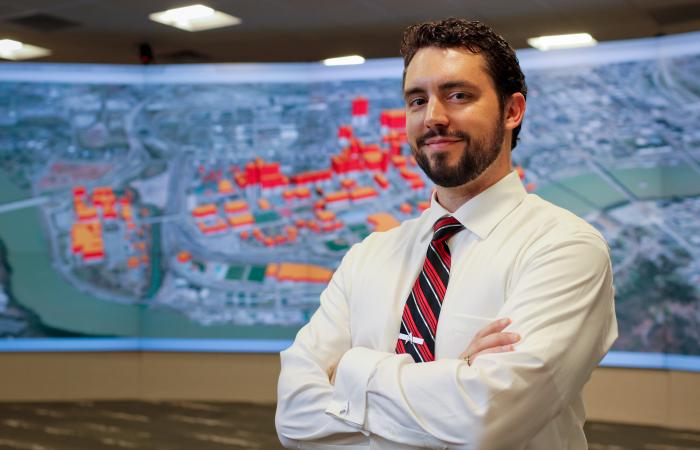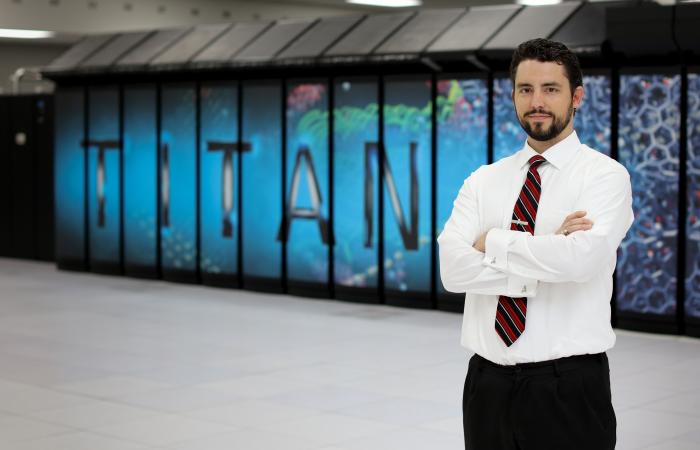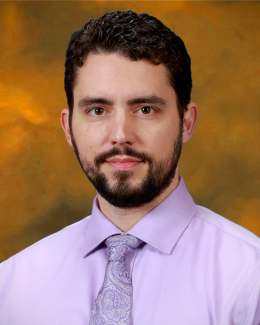Joshua New has an ambitious goal to increase the nation’s efficient use of energy: he wants to create a model of every building in America. All 130 million of them.
For now, Joshua and his colleagues in the Building Envelope and Urban Systems group are creating virtual models of the buildings in the 535-square-mile service territory of Chattanooga’s Electric Power Board —roughly 170,000 in all. The modeling team has also simulated buildings on the Oak Ridge National Laboratory campus and at the University of Tennessee, Knoxville (UTK).
The AutoBEM (Automatic Building Energy Model) program they created for the work taps satellite imagery, street views, and other publicly available data and will give insight into a building’s size and energy makeup, everything from the number of windows to heating, ventilation, and cooling systems. Using the high-performance computing assets at ORNL, the program gathers those inputs, creates a building energy model, and decides which technologies might best be employed to save energy, whether it’s a smart thermostat, advanced water heater, or other improvements.
The AutoBEM program is designed to help achieve the goal, set by the US Department of Energy’s Building Technologies Office, to reduce energy consumption per square foot in all buildings in the country by 30% by the year 2030, compared with a 2010 baseline.
Under ORNL’s Buildings Program, Joshua serves as the Building Energy Modeling subprogram manager, and is part of the national team that has developed DOE’s flagship building simulation tools such as AutoBEM, EnergyPlus, Autotune and others, to meet that goal.
EnergyPlus is an open-source modeling engine that can simulate just about any energy used in a building—capturing data on the physics of air, moisture, and heat transfer to heating and cooling systems. Autotune, which Joshua pegged as one of his team’s biggest successes, is an open source set of automated calibration techniques for fine-tuning building models to match measured data.
Autotune is used to match building models to real-world utility bills, for instance, in order to create a sufficiently accurate virtual building for business decisions. Doing so gives building owners the ability to accurately predict savings from proposed energy retrofits and thus attract private-sector funding for those improvements. The Autotune capability was built over a 5-year period using 8 supercomputers to run more than 8 million simulations and mine more than 200TB of data using 130,000 artificial intelligence algorithms, Joshua noted.
On the cutting edge with ORNL’s supercomputers
ORNL’s supercomputing capability was one of the key reasons why Joshua was attracted to the lab.
“We’re on the cutting edge in terms of infrastructure at ORNL,” Joshua said “Having something like Titan [the nation’s most powerful supercomputer], is a wonderful tool to work with.” He also praised “brilliant colleagues” at ORNL who collaborate to solve important problems.
The opportunity both to perform basic science and to help scale up applied technologies that can directly affect peoples’ lives was also a strong pull for the researcher. “ORNL is a sweet spot where I can do fundamental research, and applied research with major manufacturers, and have a foot in both worlds,” he said.
Joshua credits his father for his interest in science. His dad was a teacher and principal in Alabama, where Joshua was raised in an environment that encouraged questions and debate. He grew up playing with the new computers and other technology arriving in the classroom. In high school, Joshua developed an intense interest in physics, which carried over into his studies at Jacksonville State University. He graduated with a double major in computer science and mathematics and a physics minor before going on to earn a master’s degree at the university in computer systems and software design.
Joshua continued his studies at UTK, where he earned a Ph.D. in computer science with a specialization in graphics and visualization. The work was a natural transition to ORNL, where he worked 2-3 days a week as a graduate student. Joshua started out at ORNL’s historic Mouse House, performing genotype/phenotype correlation studies, and along the way, he has worked in areas such as materials science and climate science. In 2009, he was hired as full time staff in the Building Envelopes group.
“When you realize that there are underlying mathematical structures and numbers to every discipline, then you can take your problem and rephrase it as a graph, and apply algorithms for specific answers. It’s all a bag of numbers,” Joshua said. “It’s easy to apply well-known computational techniques to problem domains that people probably haven’t considered.”
Away from the lab, Joshua and his wife Aleah are involved parents of 4 children, ages 5 and under. He also plays volleyball—his chosen sport since childhood—in Knoxville’s city league, enjoys online gaming, and is actively involved at his church.
Joshua said one of the unifying themes of his research is automation, specifically leveraging human-computer interaction. By conveying complex data visually in a way that humans can understand, and leveraging artificial intelligence for processing interactions with underlying data, knowledge discovery can be largely automated, he said.
Joshua is constantly learning at the lab as technology advances, and often uses audiobooks to keep current on his reading—typically digesting 100 books a year. “It helps to be up to speed in your area to make cutting-edge contributions,” he said. “It’s a force multiplier—the more you know, the more you can make positive change in people’s lives.”
“I want to focus on research that results in systemic, automatic change to the benefit of millions of people,” Joshua said. “If we can create a virtual model of all the buildings in the country, it would create a huge opportunity for energy savings.”





